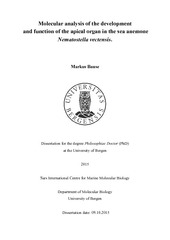| dc.description.abstract | The shapes and patterns displayed across the animal kingdom exhibit great diversity, but at the same time similarities in their appearance can be observed. Scientist in the past have studied animal forms based on morphology. In this way, comparison of animal forms has engaged generations of biologists. Nowadays, the study of the evolution of developmental mechanisms, which build these diverse forms of life, is based on molecular methods which enable comparisons across the whole width of animal diversity. Patterning along the primary body axis is a fundamental event in the life history of every animal. The correct positional information ensures that organs and organ systems develop in the right part of the body. Understanding the molecular mechanisms underlying these events is important for understanding the evolution of animal body forms, and can shed light on two questions that have puzzled evolutionary and developmental biologists for decades: How are animal axes related to each other? And: Are larval forms homologous? Both questions are crucial for revealing the characteristics of the last common ancestor of all animals and the last common ancestor of bilaterians. In the present study we are addressing these questions using the anthozoan Nematostella vectensis. This sea anemone is a member of the bilaterian sister clade Cnidaria, and has a biphasic life cycle consisting of a free-swimming larva and a solitary benthic adult. The ectoderm of the Nematostella planula larva exhibits no obvious morphological differences along the body column, except for the oral opening and the aboral apical organ. The apical organ is believed to be a larval sense organ and it plays a crucial yet poorly defined role in the transition from the larval to the juvenile stage. Despite this apparently simple axial morphology, a number of developmental genes are expressed in distinct territories along the primary body axis and these can be used as markers for specific axial regions, and used to assess patterning changes that arise from experimental manipulations. Additionally, patterning events within the developing apical organ occur and can be investigated experimentally. In this study we examined the interplay of oral and aboral signalling centres in Nematostella larvae by gene knockdown experiments as well as overexpression/overactivation experiments. We further explored modulators of the main morphogenetic pathways involved in these processes, the Wnt and the FGF pathway. Special focus arose on the HSPG (heparan sulfate proteoglycan) Glypican1/2/4/6, and differential sulfation of HS chains, as key modulators. Our results identify three steps in the establishment and patterning of the primary axis: 1) Activation of oral and aboral networks by different levels of β-catenin. 2) A feedback-loop between the transcription factor NvSix3/6 and the Wnt receptor NvFrizzled5/8 (NvFz5/8) at the aboral end of the primary axis to control the size of the aboral territory. 3) Development of position-dependent features, such as the apical organ. We further characterize NvGlypican1/2/4/6 (NvGpc1/2/4/6) and HS chain sulfation as indispensable modulators of steps 2 and 3. Specifically, at gastrula stage, knockdown of NvGpc1/2/4/6 and inhibition of glycosaminoglycan sulfation phenocopy NvFz5/8 knockdowns, as they also cause the expansion of aboral marker gene expression and the reduction of oral markers. By comparing these results to mechanisms in bilaterians, we reveal both evolutionary conservation and plasticity in the aboral/anterior patterning system of metazoans. Coming back to the two questions raised in the beginning, our results are in favour of the homology of the anterior-posterior axis in bilaterians and the oral-aboral axis in cnidarians, with the aboral pole corresponding to the anterior pole. This also provides support for the homology of marine invertebrate larvae, but a final verdict on this matter will require further research in Nematostella as well as in a broader range of other marine invertebrates. | en_US |
